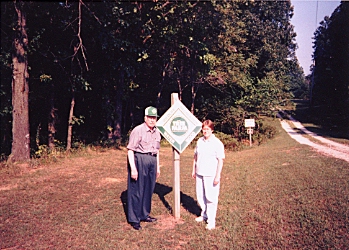Dwight Bensend and Mary Bensend Robertson have a relationship that goes beyond simply being father and daughter. Their strong relationship is based on their mutual interest in sound land stewardship.
Dwight and Mary have taken a unique approach to natural resource management on their adjoining Carroll County properties. They have coordinating Landowner Forest Stewardship Plans (LFSPs) for their Tree Farms.
Dwight Bensend and his wife Marguerite have owned a 200-acre tract adjacent to the Grand River in Carroll County for more than 20 years. During this time, they have practiced active forest management activities such as non-commercial thinnings, pecan grove management, tree planting and plantation maintenance. Wildlife management always has been a priority because several members of the Bensend family are avid whitetail deer and wild turkey hunters.
Water quality and recreation are important to the Bensends and can be seen in the construction and care of a 3-acre lake and an 8-acre wetland area.
In the interest of small game management and erosion control, nearly 20 acres of tillable ground have been enrolled in the Conservation Reserve Program and are being converted from cool-season grass to a native warm-season grass and forb mix.
Daughter Mary Robertson and husband Marc actively manage activities on the Bensend farm. In the fall they collect pecans, in the spring they plant new seedlings and, during times of flood, they help wetland cleanup efforts. Together they look forward to the time when they can retire to the property and enjoy the fruits of their labors, as Dwight and Marguerite have done.

With a recently acquired 160-acre tract south of Mary's parent's farm, the Robertsons have renewed interest in stewardship. They admit feeling a little overwhelmed by the daunting task of managing both farms appropriately.
"Marc and I work and live in Liberty. The time we get to spend at the farm is limited," says Mary. "We want to make sure the things we are busy doing there will truly help us achieve the goals Dad has set for his farm and goals we have set for our farm."
"We all realize there is a great deal of work that could be done on each farm," says Marc. "Because of the proximity, any management activity completed on one farm would benefit the resources of the other farm. We felt if we had both farms' resource needs prioritized, we would not feel quite so bewildered by what to do first."
Dwight, a distinguished retired Iowa State University professor of forest products, knew what both farms needed was a plan.
"The first step was to determine where we stood. We needed an assessment of the resources. Then we could get on with addressing the forestry and wildlife needs in an orderly fashion," he says.
Dwight contacted Missouri Department of Conservation forester Jennifer Battson. Battson helped them complete a technical assessment of the forest, open land, water and wildlife resources on both properties. She then wrote two 10-year LFSPs that considered and complemented the activities taking place on each farm. In those plans, Battson included an implementation schedule that followed the same considerations.
"I tried to keep in mind that the Bensends and Robertsons were going to be helping each other complete the management activities. Essentially, I looked at the two tracts as one. They had to be separated for purposes of tracking potential cost-share, but I made my suggestions as though they were under a single owner," says Battson.
"It's nice to know that for the next 10 years each property's goals and objectives have been clearly identified and agreed upon. Instead of first doing those activities that come easiest, we can focus on the work that will have the greatest impact," says Mary.
"Also, Dad and Mother can potentially pass on a forest stewardship legacy to all of their family in the form of a plan for their property."
- Jennifer Battson, Management Forester, MDC